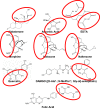A common molecular motif characterizes extracellular allosteric enhancers of GPCR aminergic receptors and suggests enhancer mechanism of action
- PMID: 25174918
- PMCID: PMC4266041
- DOI: 10.2174/0929867321666140826120604
A common molecular motif characterizes extracellular allosteric enhancers of GPCR aminergic receptors and suggests enhancer mechanism of action
Abstract
Several classes of compounds that have no intrinsic activity on aminergic systems nonetheless enhance the potency of aminergic receptor ligands three-fold or more while significantly increasing their duration of activity, preventing tachyphylaxis and reversing fade. Enhancer compounds include ascorbic acid, ethylenediaminetetraacetic acid, corticosteroids, opioid peptides, opiates and opiate antagonists. This paper provides the first review of aminergic enhancement, demonstrating that all enhancers have a common, inobvious molecular motif and work through a common mechanism that is manifested by three common characteristics. First, aminergic enhancers bind directly to the amines they enhance, suggesting that the common structural motif is reflected in common binding targets. Second, one common target is the first extracellular loop of aminergic receptors. Third, at least some enhancers are antiphosphodiesterases. These observations suggest that aminergic enhancers act on the extracellular surface of aminergic receptors to keep the receptor in its high affinity state, trapping the ligand inside the receptor. Enhancer binding produces allosteric modifications of the receptor structure that interfere with phosphorylation of the receptor, thereby inhibiting down-regulation of the receptor. The mechanism explains how enhancers potentiate aminergic activity and increase duration of activity and makes testable predictions about additional compounds that should act as aminergic enhancers.
Figures







Similar articles
-
Tartaric Acid Enhances Adrenergic Receptor Activity: Test of a General Theory of Extracellular Aminergic GPCR Enhancer Discovery.Curr Drug Discov Technol. 2014;11(4):293-307. doi: 10.2174/157016381104150507121846. Curr Drug Discov Technol. 2014. PMID: 25985862
-
A structural chemogenomics analysis of aminergic GPCRs: lessons for histamine receptor ligand design.Br J Pharmacol. 2013 Sep;170(1):101-26. doi: 10.1111/bph.12248. Br J Pharmacol. 2013. PMID: 23713847 Free PMC article.
-
Aminergic GPCR-Ligand Interactions: A Chemical and Structural Map of Receptor Mutation Data.J Med Chem. 2019 Apr 25;62(8):3784-3839. doi: 10.1021/acs.jmedchem.8b00836. Epub 2018 Nov 27. J Med Chem. 2019. PMID: 30351004 Review.
-
The second extracellular loop of the adenosine A1 receptor mediates activity of allosteric enhancers.Mol Pharmacol. 2014 Feb;85(2):301-9. doi: 10.1124/mol.113.088682. Epub 2013 Nov 11. Mol Pharmacol. 2014. PMID: 24217444 Free PMC article.
-
A Novel "Activation Switch" Motif Common to All Aminergic Receptors.J Chem Inf Model. 2023 Aug 28;63(16):5001-5017. doi: 10.1021/acs.jcim.3c00732. Epub 2023 Aug 4. J Chem Inf Model. 2023. PMID: 37540602 Free PMC article. Review.
Cited by
-
Chemical signaling in the developing avian retina: Focus on cyclic AMP and AKT-dependent pathways.Front Cell Dev Biol. 2022 Dec 9;10:1058925. doi: 10.3389/fcell.2022.1058925. eCollection 2022. Front Cell Dev Biol. 2022. PMID: 36568967 Free PMC article. Review.
-
Co-Evolution of Opioid and Adrenergic Ligands and Receptors: Shared, Complementary Modules Explain Evolution of Functional Interactions and Suggest Novel Engineering Possibilities.Life (Basel). 2021 Nov 10;11(11):1217. doi: 10.3390/life11111217. Life (Basel). 2021. PMID: 34833093 Free PMC article.
-
Dopamine Promotes Ascorbate Release from Retinal Neurons: Role of D1 Receptors and the Exchange Protein Directly Activated by cAMP type 2 (EPAC2).Mol Neurobiol. 2018 Oct;55(10):7858-7871. doi: 10.1007/s12035-018-0962-7. Epub 2018 Feb 23. Mol Neurobiol. 2018. PMID: 29476450
-
Individual differences in behavioral effects of xylazine and opioid-xylazine mixtures in male rats.bioRxiv [Preprint]. 2025 Jun 27:2025.06.25.661558. doi: 10.1101/2025.06.25.661558. bioRxiv. 2025. PMID: 40667147 Free PMC article. Preprint.
-
Glutathione and Glutathione-Like Sequences of Opioid and Aminergic Receptors Bind Ascorbic Acid, Adrenergic and Opioid Drugs Mediating Antioxidant Function: Relevance for Anesthesia and Abuse.Int J Mol Sci. 2020 Aug 28;21(17):6230. doi: 10.3390/ijms21176230. Int J Mol Sci. 2020. PMID: 32872204 Free PMC article.
References
-
- Trumpp-Kallmeyer S, Hoflack J, Bruinvels A, Hibert M. Modeling of G-protein-coupled receptors: application to dopamine, adrenaline, serotonin, acetylcholine, and mammalian opsin receptors. J. Med. Chem. 1992;35(19):3448–3462. - PubMed
-
- Bylund D B, Eikenberg D C, Hieble J P, Langer S Z, Lefkowitz R J, Minneman K P, Molinoff P B, Ruffolo R R , Jr, Trendelenburg U. International Union of Pharmacology nomenclature of adrenoceptors. Pharmacol. Rev. 1994;46:121–136. - PubMed
-
- Valant C, Aurelio L, Urmaliya V B, White P, Scammells P J, Sexton P M, Christopoulos A. Delineating the mode of action of adenosine A1 receptor allosteric modulators. Mol. Pharmacol. 2010;78:444–455. - PubMed
-
- Gilchrist A. Modulating G-protein-coupled receptors, from traditional pharmacology to allosterics. Trends Pharmacol. Sci. 2007;28:431–437. - PubMed
-
- Bridges T M, Lindsley C W. G-protein-coupled receptors, from classical modes of modulation to allosteric mechanisms. A.C.S. Chem. Biol. 2008;3:530–541. - PubMed
MeSH terms
Substances
LinkOut - more resources
Full Text Sources
Other Literature Sources

